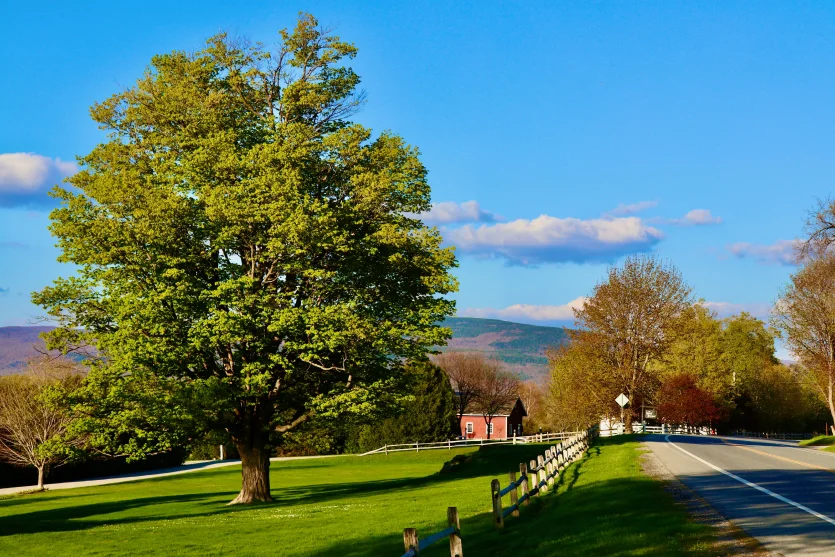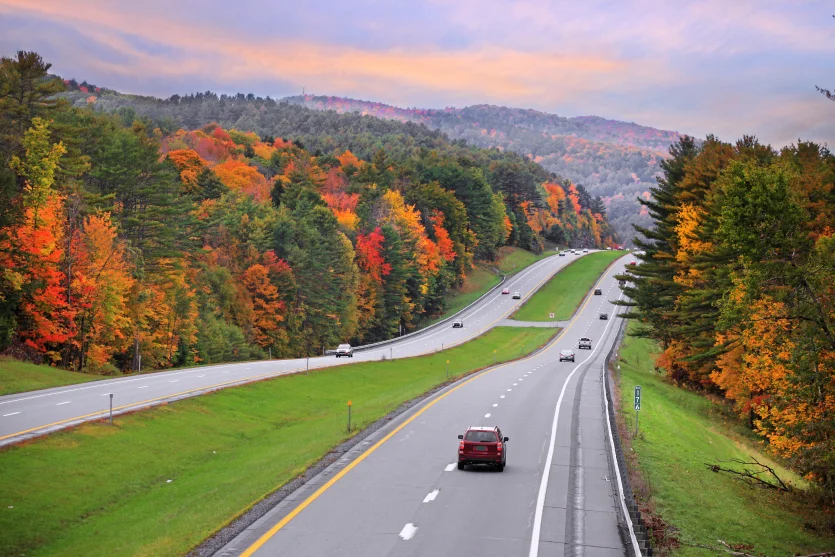
Vermont Car Insurance
Everything You Need to Know About Auto Insurance in Vermont
Vermont is an enchanting state in the northeastern United States known for its natural beauty. There you can find picturesque landscapes, including rolling hills, lakes and forests. The state offers opportunities for outdoor activities such as hiking, fishing, and skiing, making it a popular destination for nature enthusiasts.
In addition to its scenic charm, Vermont is also renowned for its towns and historic sites. Travelers can stroll through streets lined with traditional New England architecture, visit shops and cafes, and appreciate the rich history and culture of the state. Whether it’s exploring the lively city of Burlington or discovering the tranquility of small villages, Vermont provides a memorable experience for all.
If you live in or are planning a trip to Vermont, it’s important to ensure that you have adequate auto insurance coverage. InsureOne provides the best auto insurance at the most affordable prices, giving you peace of mind as you drive through the state’s roads.
How Much Does Car Insurance Cost in Vermont?
In Vermont, drivers pay an average of $1,061 annually for full coverage car insurance and $238 annually for minimum coverage. These rates are significantly lower than the national average, which stands at $2,014 per year for full coverage and $622 per year for minimum coverage.
Additionally, Vermont drivers enjoy lower insurance costs compared to some neighboring states. For instance, in the nearby state of New Hampshire, the average cost of car insurance is $1,262 per year for full coverage and $319 per year for minimum coverage.
However, despite already enjoying competitive rates, there are still opportunities for Vermont drivers to save even more on their car insurance.
Reasons Why Insurance is so Cheap in VT
With less than 650,000 residents, Vermont ranks among the states with the lowest population size. As a result, rates are generally lower in Vermont due to fewer drivers on the road translating to fewer accidents and claims.
However, car insurance premiums can vary significantly for everyone. Even neighbors on the same street can pay different prices due to personal details such as age, credit score, and other factors, which will be revealed in the following paragraphs.
Affordable Car Insurance Rates Comparison by Cities in Vermont
For a comparison of the average monthly premiums paid by drivers in different Vermont cities, check out our breakdown below.
| City | Full Coverage Insurance | Liability Insurance Coverage |
|---|---|---|
| Burlington | $96 | $28 |
| South Burlington | $96 | $28 |
| Rutland | $97 | $26 |
| Essex Junction | $97 | $28 |
| Bennington | $99 | $26 |
| Middlebury | $95 | $25 |
Our average monthly premiums by city are based on the following methodology: male, age 30, lowest possible legal coverage allowed in Vermont.

How Bundling Your Vehicle and Homeowners Insurance Can Save You Money in VT
Vermont residents can enjoy substantial savings by bundling their car and homeowners insurance policies. This opportunity could potentially save them $279 per year, which equates to around 15% of their total premium cost.
Moreover, bundling insurance policies makes things easier for policyholders by consolidating both policies with just one insurance provider. It reduces the hassle of dealing with multiple companies, streamlining the process.
To grab hold of these savings, reach out to the knowledgeable agents at InsureOne. They’ll guide you through the process and help you find personalized options that best fit your needs and budget.
What Types of Auto Discounts Are Available in Vermont?
There are several types of auto discounts available in Vermont, including:
- Good driver: Maintaining a clean driving record with no claims for the past three years can lead to lower monthly premiums.
- Multi-car: Provides reduced quotes per vehicle when insuring multiple cars.
- Defensive driving course: Rewards drivers who complete safety courses with lower premiums.
- Low-mileage: Offers lower rates to drivers who drive fewer than 7,500 miles annually.
- Good student: A benefit offered to young drivers who consistently maintain higher grades in school.
- Military: Available to current and former military personnel.
Don’t forget to have a conversation with your insurance agent and inquire about all the discounts that are available.
Vermont Car Insurance Laws
Vermont has strict requirements for car insurance, which includes a minimum amount of coverage. Insurance companies are required to maintain a real-time database, updating the status of policyholders’ coverage to ensure that both law enforcement and the state can identify which vehicles are insured and uninsured.
Even a single day lapse in your car insurance coverage can lead to an automatic report to the state, triggering a request from them to provide proof of insurance.
What Are the Mandatory Car Insurance Requirements in VT?
Vermont requires minimum car insurance for vehicles registered in the state. The minimum coverage includes:
- $25,000 bodily injury liability per person
- $50,000 bodily injury liability per accident
- $10,000 property damage liability
- $50,000 uninsured/underinsured motorist coverage per person
- $100,000 uninsured/underinsured motorist coverage per accident
- $10,000 uninsured/underinsured property damage coverage
Vermont follows an at-fault system for car accidents. This means that the at-fault driver’s insurance company is responsible for covering the medical bills and repair costs of the other party, within the policy limits.
The state minimums in Vermont are low, so it is advisable to set higher liability limits to ensure you are adequately covered in the event of an accident that you cause.
What Is the Penalty for Driving Without Insurance in Vermont?
Driving uninsured in Vermont is a severe traffic violation that results in license suspension, high fines, and expensive auto policies. If caught, expect civil penalties of at least $500 and the need for an SR-22 certificate, showing financial responsibility and minimum state-required coverage.
An SR-22 is also required for a DUI/DWI conviction, severe car accident, suspended license, or accumulating too many points on your license. Premiums will increase depending on the accident or violation. Always keep your insurance card with you, even with an electronic ID card.
What Factors Does Vermont Law Allow in Determining Your Premiums?
When calculating car insurance rates, insurers take into account various factors. Aside from age, gender, and zip code, they consider:
- Claims history
- Marital status
- Credit history
- Driving record
- Vehicle type
What Happens if I Damage Property?
If you are the at-fault driver in an accident that damages another vehicle, a homeowner’s fence, or a road sign, your insurer will cover the repairs up to your property damage liability limit.
In Vermont, the minimum limit for property damage liability is only $10,000. Therefore, if the cost of repairs exceeds this amount, you may have to pay out of pocket or face the risk of being sued and having your assets seized.
It’s important to remember that property includes personal belongings owned by someone, such as fences or mailboxes.
Public property, on the other hand, refers to items owned by the government, such as public mailboxes, guardrails, and stop signs. For example, the average cost of damaging a traffic signal is $3,000, and the average cost of damaging guardrails is $900. These repair costs will need to be paid through your property damage insurance. However, any amount exceeding the coverage limit will be your responsibility to pay out of pocket.
At InsureOne, we can find the auto insurance policy that best suits your needs, offering customizable options matched to your situation with protection against property damage expenses.

What Is Driving Like in the Green Mountain State?
When driving in Vermont, it’s important to be prepared for various weather conditions that can affect driving.
During heavy snowfall, use snow tires or chains, drive slowly, and maintain a safe following distance. In freezing temperatures, clear ice and snow from your vehicle, use your headlights and defrost settings, and slow down on icy roads.
When encountering fog, use low-beam headlights and reduce speed. Be mindful of distractions caused by vibrant fall foliage and stay focused on the road. During spring flooding, avoid driving through flooded areas and be aware of road closures.
In windy conditions, maintain a firm grip on the steering wheel and adjust your speed. Lastly, stay informed about severe storms, avoid driving in severe weather if possible, and pull over to a safe location if conditions worsen.
Taking these tips into consideration will help ensure a safer driving experience in this state.
How Many Car Accidents Happen in Vermont?
In 2021, a total of 69 fatal crashes were registered in Vermont, resulting in the loss of 74 lives in total. However, in 2022, the number of deaths slightly decreased to 71 people during that year. The main cause of these accidents has been impaired driving, excessive speed, distracted driving, and failure to use seatbelts.
The following table displays the number of fatal motor vehicle crashes that occurred in different counties and cities of this state during 2021.
| County or City | Fatal Crashes in 2021 |
|---|---|
| New Haven City | 1 |
| Bennington County | 7 |
| Addison County | 3 |
| Essex County | 2 |
| Charlotte City | 1 |
Source: U.S. Department of Transportation National Highway Traffic Safety Administration.
How Many Uninsured/Underinsured Motorists Are in VT?
According to the latest statistics from the Insurance Information Institute, Vermont ranks 37th in the country for having one of the lowest numbers of uninsured drivers.
Regardless of the state’s relatively low percentage of uninsured drivers, having proper coverage remains indispensable for all drivers to mitigate potential financial hardships that may arise from unforeseen circumstances on the road.

Get the Best Car Insurance in Vermont Today
Get excellent insurance coverage from InsureOne at competitive prices. Our experienced agents will efficiently find multiple quotes that are tailored to your unique needs, helping you save money.
We make obtaining a quote easy and convenient. You can request a quote online, visit one of our offices, or contact our team directly at (800) 836-2240 for personalized assistance.


